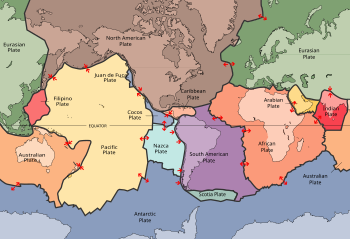Plate tectonics
From Wikipedia, the free encyclopedia
Plate tectonics (from Greek τέκτων, tektōn "builder" or "mason") describes the large scale motions of Earth's lithosphere. The theory encompasses the older concepts of continental drift, developed during the first half of the 20th century, and seafloor spreading, understood during the 1960s.
The outermost part of the Earth's interior is made up of two layers: above is the lithosphere, comprising the crust and the rigid uppermost part of the mantle. Below the lithosphere lies the asthenosphere. Although solid, the asthenosphere has relatively low viscosity and shear strength and can flow like a liquid on geological time scales. The deeper mantle below the asthenosphere is more rigid again due to the higher pressure.
The lithosphere is broken up into what are called tectonic plates — in the case of Earth, there are seven major and many minor plates (see list below). The lithospheric plates ride on the asthenosphere. These plates move in relation to one another at one of three types of plate boundaries: convergent or collision boundaries, divergent or spreading boundaries, and transform boundaries. Earthquakes, volcanic activity, mountain-building, and oceanic trench formation occur along plate boundaries. The lateral movement of the plates is typically at speeds of 50—100 mm/a.[1]

No comments:
Post a Comment